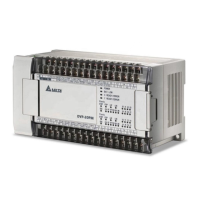5 Applied Instructions and Basic Usage
DVP-20PM Application Manual
5-233
Flying shear is applied to equipment which needs to move with processed objects, e.g. a tube
h a
ter the processing axis moves to the synchronization zone designed, the speed
s will be the same as the speed of the processed object. After the processing
axis leaves the synchronization zone, it will return to its original position. The feeding axis (master
axis) used always feed materials at a uniform speed.
cutter. The processing axis (slave axis) used accelerates at first so that it can catch up wit
processed object. Af
of the processing axi
Positive area
Negative area
Position of the master axis
Ratio of the speed
of the slave axis
specified to the
speed of the master
axis specified
Position of the master axis
The slave axis
begins to
operate.
Synchronization zone
The slave axis returns to
its original position.
Zone in which the
slave axis waits
The slave axis stops to
move in the negative
direction.
The slave axis finishes
processing an object.
The slave axis
begins to process
an object.
Processing signal
sent by the slave axis
ovement of a flying shear is composed of catching up with an object and returning to the
sition of the flying shear. The two distances for which the flying shear moves must be the
same. In terms of the speed the flying shear, the positive area in which the flying shear moves must
be equal to the negative area in which the flying shear moves.
When the processing axis used process an object, the feeding axis used does not stop. The speed
of the processing axis must be the same as the speed of the feeding axis. The time in which the
processing axis is synchronized with the feeding axis must be long enough for the completion of the
processing of an object and the movement of the object to a safe place.
The length of the synchronization zone designed is the time it takes for the processing axis used to
process an object. Besides, the design of a synchronization zone affects the operation of
equipment. The bigger the synchronization zone is in a cycle, the less time it takes for the slave
axis specified to accelerate/decelerate. If equipment needs to accelerate/decelerate in a short time,
there will be a great impact on the electric machinery used and the blade used, and there will be an
overcurrent passing through the servo used.
2. Input pins/Output pins
The m
original po
Input pin
Name Function
Data
type
Setting value Time when a value is valid
Master
Master axis
number
WORD
K1: A0± and B0±
K2: FP± for the Y-axis
(No external wiring is
needed.)
K3: FP± and RP± for
the Y-axis
(No
external wiring is
needed.)
The value of the Master input pin is
valid when there is a transition in the
Enable input pin’s signal from low to
high.
Enable
Enabling
electronic
cam motion
BOOL True/False -
SlavePulseInType Pulse type WORD
K0: mcUD
K1: mcPD
K2: mcAB
K3: mc4AB
The value of the SlavePulseInType
input pin is valid when there is a
transition in the Enable input pin’s
signal from low to high.

